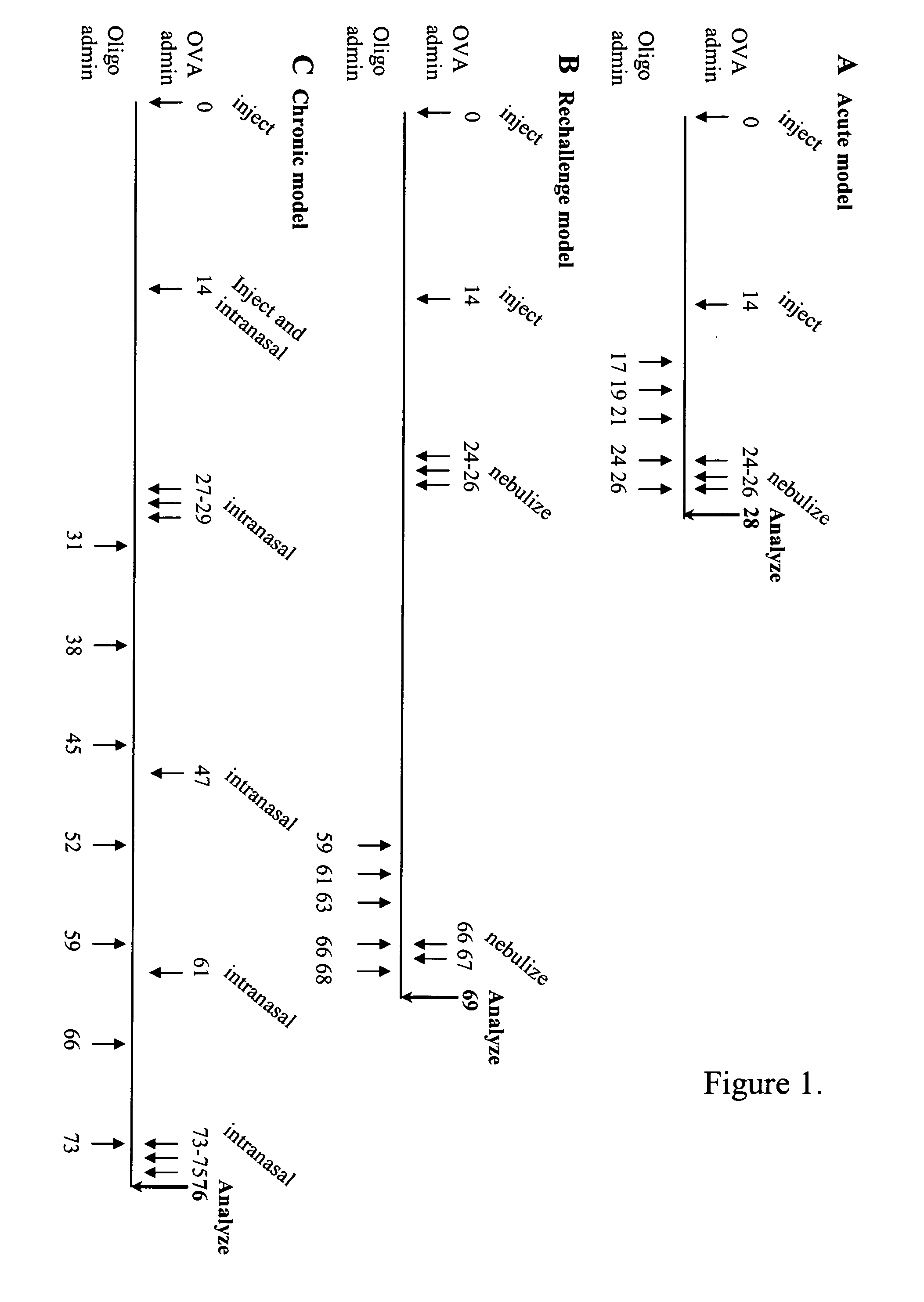Compositions and their uses directed to thymus and activation-regulated chemokine (TARC)
- Summary
- Abstract
- Description
- Claims
- Application Information
AI Technical Summary
Problems solved by technology
Method used
Image
Examples
example 1
Transfection Methods
Cell Types
[0096] The effect of antisense compounds on target nucleic acid expression was tested in the following cell types.
A549:
[0097] The human lung carcinoma cell line A549 was obtained from the American Type Culture Collection (Manassas, Va.). A549 cells were routinely cultured in DMEM, high glucose (Invitrogen Life Technologies, Carlsbad, Calif.) supplemented with 10% fetal bovine serum, 100 units per ml penicillin, and 100 micrograms per ml streptomycin (Invitrogen Life Technologies, Carlsbad, Calif.). Cells were routinely passaged by trypsinization and dilution when they reached approximately 90% confluence. Cells were seeded into 96-well plates (Falcon-Primaria #3872) at a density of approximately 5000 cells / well for use in antisense compound transfection experiments. 3T3-L1:
[0098] 3T3-L1, undifferentiated: The mouse embryonic adipocyte-like cell line 3T3-L1 was obtained from the American Type Culture Collection (Manassas, Va.). 3T3-L1 cells were r...
example 2
Real-time Quantitative PCR Analysis of TARC mRNA Levels
[0104] Quantitation of TARC mRNA levels was accomplished by real-time quantitative PCR using the ABI PRISM™ 7600, 7700, or 7900 Sequence Detection System (PE-Applied Biosystems, Foster City, Calif.) according to manufacturer's instructions.
[0105] Prior to quantitative PCR analysis, primer-probe sets specific to the target gene being measured were evaluated for their ability to be “multiplexed” with a GAPDH amplification reaction. After isolation the RNA is subjected to sequential reverse transcriptase (RT) reaction and real-time PCR, both of which are performed in the same well. RT and PCR reagents were obtained from Invitrogen Life Technologies (Carlsbad, Calif.). RT, real-time PCR was carried out in the same by adding 20 μL PCR cocktail (2.5× PCR buffer minus MgCl2, 6.6 mM MgCl2, 375 μM each of dATP, dCTP, dCTP and dGTP, 375 nM each of forward primer and reverse primer, 125 nM of probe, 4 Units RNAse inhibitor, 1.25 Units PL...
example 3
Antisense Inhibition of Human TARC Expression by Antisense Compounds
[0110] A series of antisense compounds was designed to target different regions of human TARC RNA, using published sequences or portions of published sequences as cited in Table 1. Methods for designing and testing antisense oligonucleotides for inhibition of mRNA target expression are discussed herein and well known to those skilled in the art. The screen identified active target segments within the human TARC mRNA sequence, specifically GenBank number NM—002987.2 (SEQ ID NO: 1). Each active target segment was targeted by multiple, active antisense oligonucleotides were targeted. These regions include nucleotides 60 to 172, including the subset of 60 to 100, and nucleotides 574 to 605 of SEQ ID NO: 1. Each of the oligonucleotides tested within each of these regions inhibited expression of human TARC at least 25%. Over half of the oligonucleotides tested inhibited expression at least 40%. In a preferred embodiment,...
PUM
| Property | Measurement | Unit |
|---|---|---|
| Fraction | aaaaa | aaaaa |
| Fraction | aaaaa | aaaaa |
| Fraction | aaaaa | aaaaa |
Abstract
Description
Claims
Application Information
 Login to View More
Login to View More - R&D
- Intellectual Property
- Life Sciences
- Materials
- Tech Scout
- Unparalleled Data Quality
- Higher Quality Content
- 60% Fewer Hallucinations
Browse by: Latest US Patents, China's latest patents, Technical Efficacy Thesaurus, Application Domain, Technology Topic, Popular Technical Reports.
© 2025 PatSnap. All rights reserved.Legal|Privacy policy|Modern Slavery Act Transparency Statement|Sitemap|About US| Contact US: help@patsnap.com

